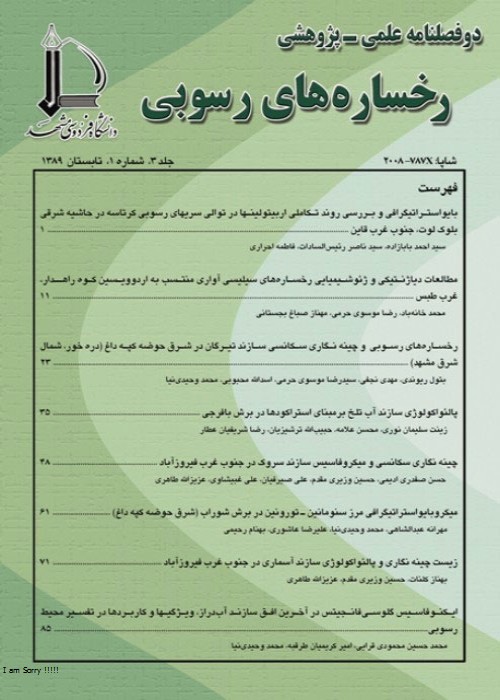Sedimentary facies and Depositional environment of the Tirgan Formation in the Bazangan Area, E Kopet-Dagh Basin
The Kopet-Dagh sedimentary Basin that crops out from NE Iran to Turkmenistan was formed as an intracontinental Basin due to the southeastern extension of the South Caspian Basin by Neotethyan back-arc rifting after the closure of the Palaeotethys and the early Cimmerian Orogeny (middle Triassic). A thick sedimentary package (10 kilometers) consisting of five transgressive- regressive super-sequences from Jurassic to Miocene time is deposited in the Eastern part of the sedimentary basin that is mainly controlled by NW-SW running major faults. The Cretaceous sequence in the Kopet-Dagh Basin is divided into nine formations, mainly composed of sandstones, conglomerates, mudstones, limestones, and dolomites with minor amounts of evaporates (Afshar-Harb, 1979). The regional trend of the Kopet-Dagh sedimentary basin was northwest-southeast during the Cretaceous. After the deposition of thick, red siliciclastic sediments of the fluvial system during the Early Cretaceous, a suitable condition for the deposition of carbonate sediments (named as Tirgan Formation) was provided as a result of major marine transgression during the Barremian-Aptian stages. The Tirgan Formation is one of the most widespread Upper Cretaceous formations in the eastern Kopet-Dagh that unconformably overlies the fluvial sediments of the Shurijeh Formation and is overlain by a sharp contact of the Sarcheshmeh Formation.
This study is focused on two stratigraphic sections in the Eastern Kopet-Dagh in northern Iran. Ninety thin sections were examined to identify fine-scale physical characteristics (mineralogical composition and fossil contents). Lithology, grain size, and sedimentary structures were recorded.
Based on sedimentological features, sixteen facies are recognized that grouped within five facies associations consist of deep and shallow open marine (FA), shoal (FB), lagoon (FC), and Tidal flat (FD). Deep open marine facies include green-gray fissile (sandy-silty) shale and shallow open marine facies are mainly consist of bioclastic wackestone, ooid/peloid bioclastic floatstone, sandy intraclastic floatstone, sandy intraclastic bioclastic float-rudstone, and sandy peloid bioclastic grainstone. The main constituents in this association are brachiopods, bryozoans, echinoderms, oysters, orbitolinids, intraclasts, ooids, and peloids. Micrite envelopes and borings are the common features in this association. The skeletal elements display high fragmentation, preferentially horizontal orientation, and fining up-ward fabrics. Green-gray fissile shale is deposited in a low energy depositional setting below weather wave base (SWWB), periodically affected by storm waves, suggested by the presence of the siliciclastic grains. The skeletal elements of the shallow open marine facies offer a shallow full open marine setting between SWWB and fair-weather wave base (FWWB) (Bovar-Arnal et al., 2009). High fragmentation, preferentially horizontal orientation, and fining upward skeletal elements suggest the storm-generated shell concentrations. Low energy periods of the sedimentary environment (post- and pre-storm phase) are indicated by micrite envelopes and borings. Shoal association consists of ooid grainstone and sandy ooid grainstone facies with predominantly well-sorted fabric. The main sedimentary structures in this association are sigmoidal cross-beds, wave ripples, cross lamination, and planar cross-beds with the erosional surface. These sediments are deposited in medium-high energy shoal settings above FWWB in the inner ramp environment suggested by well sorting of the elements and predominantly grainstone facies (Bachmann & Hirsch, 2006; Brandano et al., 2012). The sedimentary structures clearly show that tidal currents controlled the association's deposition in a sandy shoal environment. Lagoon association includes sandy mudstone, bioclastic wack-packstone, sandy ooid wackestone, sandy peloid packstone, intraclast, ooid float-rudstone, ooid/peloid pack-grainstone, ooidal bioclastic float-rudstone with main ooids, peloids, benthic foraminifers, echinoderms, and minor content of green algae, bivalves, brachiopods as well as siliciclastic grains that are commonly floated in the micritic matrix. These sediments are mainly deposited in a semi-restricted to restricted (sandy mudstone) lagoon setting above FWWB. The periodical water circulation suggested by the mixture of the open marine (echinoderm, brachiopods) to more restricted and brackish water elements (ostracodes, benthic forams), floated within the micritic matrix (Colombie & Strasser, 2005; Bachmann & Hirsch, 2006; Bovar-Arnal et al., 2009). The tidal flat association mainly consists of peloids, benthic foraminifers, and ostracods surrounded by flat microbial laminations. The flat geometry of the microbial lamination and the presence of the peloids and benthic foraminifers as the main elements in this association demonstrate a flat substrate in a tidal flat setting of the most internal part of the carbonate platform.
In a general view, petrography and field observations, facies associations relationship, and vertical trend of the studied successions suggest Tirgan sediments in the Kopet-Dagh basin are deposited in shallow to the deep marine environment with tidal flat, lagoon, shoal, and shallow to deep marine facies zones. These sediments were deposited in a homoclinal ramp characterized by gradationally vertical changes in the facies associations and abundant storm deposits. This carbonate system was influenced by storm (shallow marine zone) and tidal (shoal zone) currents suggested by the storm-generated shell concentrations, wave ripples, cross laminations, and sigmoidal cross-beds.


